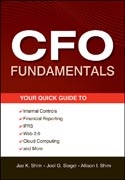
CFO fundamentals: your quick guide to internal controls, financial reporting, IFRS, web 2.0, cloud computing, and more
Shim, Jae K.
The thorough reference that goes wherever you go The Complete CFO Reference is the perfect up-to-date reference tool for today's busy CFO, controller, treasurer, and other finance professionals. Written in an easy format and packed with checklists, samples, and worked-out solutions for a wide variety of accounting and finance problems, readers can take this handy reference wherever theygo-on a business trip, visiting a client, conducting a conference call, or attending a meeting. Covers all major developments in finance and accounting every CFO needs to know about including IFRS, Web-based planning, and ranging from financial reporting and internal control to financial decision making for shareholder value maximization Includes tables, forms, checklists, questionnaires, practical tips, and sample reports Incorporates Accounting Standards Codification (ASC) throughout the book, as well as coverage of International Financial Reporting Standards (IFRS) and its impact on financial reporting, XBRL reporting, risk management and disaster recovery, Web-based planning and budgeting, Web 2.0, cloud computing, and environmental costing Simplifying day-to-day work in dozens of critical areas, The Complete CFO Reference is the perfect up-to-date reference tool for today's busy chief financial officer (CFO), controller, treasurer, financial director, budgeting director, and other financial professionals in public practice and private industry. INDICE: What This Book Will Do for You Part 1 Reports and Filings One Chief Financial Officer's Role and Reports The Role of the Chief Financial OfficerGovernmental Reporting Reporting Under the Sarbanes-Oxley Act Extensible Business Reporting Language (Xbrl) Reporting Other Reporting Two Securities and Exchange Commission Filings SEC Rules S Forms SEC Regulations SOX Reporting requirements Part 2 Financial Reporting Three Financial Statement Reporting: The Income Statement Revenue Recognition Construction Contracts Expense RecognitionFour Financial Statement Reporting: The Balance Sheet Accounts Receivable Inventory Fixed Assets Liabilities Accounting for Compensated Absences Environmental Obligations Fair Value Measurements The Fair Value Option for Financial Assets and Financial Liabilities Electing the Fair Value Option Statement of Cash Flows Available-for-Sale and Held-to- Maturity Securities Five Statement of Cash Flows Classifications of Cash Flow Analysis of the Statement of Cash Flows Six Accounting and Disclosures Accounting Changes Futures Contracts Various Disclosures Seven Key Financial Accounting Areas Consolidation Investments in Stocks and Bonds Leases 1 Pension Plans Postretirement Benefits Excluding Pensions Income Tax Allocation Foreign Currency Accounting International FinancialReporting Standards (IFRS) Eight Interim and Segmental Reporting Interim Reporting Segmental Reporting Part 3 Cost Management and IT Systems Nine Cost Management and Analysis Strategic Cost Management Activity-Based Costing (ABC) Activity-Based Management (ABM) Target Costing and Pricing Ten Cost-Volume-ProfitAnalysis and Leverage Cost-Volume-Profit Analysis What-If Analysis Sales-Mix Analysis CVP Analysis for Nonprofit Organizations Leverage Eleven Short-Term Decisions Relevant Costs The Best Use of Scarce Resources The Theory of Constraints Twelve Financial Forecasting, Planning, and Budgeting Financial Forecasting: The Percent-of-Sales Method Budgeting Using an electronic spreadsheet to develop a budget plan Budgeting Software The Latest Generation of Budgeting andPlanning (Bthe Capital Asset Pricing Model (CAPM) The Arbitrage Pricing Model(APM) Fourteen Capital Budgeting and Real Options Time Value Fundamentals Popular Evaluation Techniques Profitability Index (or Present Value Index) Limited Funds for Capital Spending Real Options Discovery-Driven Planning Effect of Income Taxes on Capital Budgeting Decisions Fifteen The What and Why of Responsibility Accounting Cost Center Performance and Standard Costs Flexible Budgets and Performance Reports Production Mix and Yield Variances Sixteen Control of Profit Centers Profit Variance Analysis Seventeen Performance of Investment Centers and Transfer Pricing Rate of Return on Investment (ROI) Residual Income (RI) Investment Decisions Under ROI and RI Transfer Pricing Eighteen How to Analyze and Improve Corporate Profitability and Shareholder Value Measures of Managerial Performance and Shareholder Return
- ISBN: 978-1-118-13249-4
- Editorial: John Wiley & Sons
- Encuadernacion: Rústica
- Páginas: 754
- Fecha Publicación: 14/03/2012
- Nº Volúmenes: 1
- Idioma: Inglés
